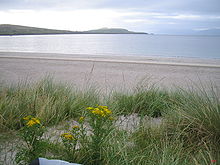- Cath Finntrágha
-
Cath Finntrágha [kaθ 'fʴiNtraːɣa], auch Cath Finntrága („Die Schlacht von Ventry“) ist eine Erzählung aus dem Finn-Zyklus der Irischen Mythologie. Das Werk entstand vermutlich Mitte des 15. Jahrhunderts, andere Autoren nehmen eine Fassung an, die bis in das 12. Jahrhundert zurückgeht. Der Bericht liegt in einer Vielzahl von Manuskripten vor. Der älteste namentlich bekannte Schreiber ist Finnlaech Ó Cathasaigh (vor 1471).
Inhalt
Fionn mac Cumhaill und seine Fianna verteidigen Irland mit Hilfe des Elfenfürsten Bodb Derg, dem Herrscher des Síd al Femen, gegen fremde Eindringlinge unter der Führung des „Königs der Welt“ (rí an domhain). Diese landen an der Küste bei Ventry (irisch Finntraighe, „schöner Strand“) auf der Dingle-Halbinsel (County Kerry) im Südwesten Irlands, wo auch die entscheidende Schlacht stattfindet. Trotz der Untätigkeit des Hochkönigs Cormac mac Airt auf Tara, der Finn seinen Einfluss und seine Volkstümlichkeit neidet, werden die Aggressoren besiegt und keiner der Fremden überlebt die Schlacht.
Siehe auch
- Mythen und Sagen aus Irland
- Liste keltischer Götter und Sagengestalten
Literatur
- Bernhard Maier: Lexikon der keltischen Religion und Kultur. Kröner, Stuttgart 1994, ISBN 3-520-46601-5.
- Kuno Meyer 1885. Cath Finntrága (englische Übersetzung). Oxford: Clarendon Press.
- Bianca Ross 1988, Britannia et Hibernia, nationale und kulturelle Identitäten im Irland des 17. Jahrhunderts. Heidelberg: Verlagshaus Winter.
Wikimedia Foundation.

